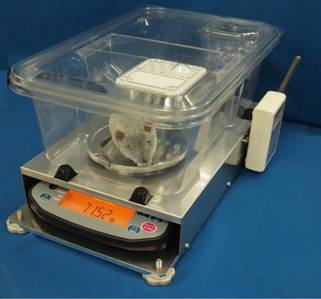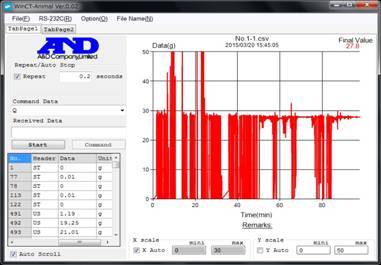Support
Story 35: Development of Balance for Animals
- AD-1642A
June 26, 2015
Development of Balance for Animals
Naoto Izumo
R&D Division 5, A&D Company, Limited
Animal testing is used to accomplish the crucial task of evaluating the safety and effect of medicine before testing on humans occurs in the development process for new medicines. At facilities that perform these tests many tools ranging from balances for measuring weight to microscopes for observation are used for analysis.
In the past analytical experiments were commonly performed on animals to investigate the weight change of internal organs after medicine was administered as well as the biological responses of certain organs. However, an increased focus on animal welfare has led to a strong push toward reducing live dissections that accompany analytical experiments.
In recent years there have been ongoing attempts to measure the behavior patterns that indicate an animal's health condition as well as changes in the voluntary activity of animals. This includes determining the behavior patterns and symptoms of the animal's psychological state to try to see the effect of the drugs on the animal's behavior. These methods are linked to the movement towards conducting appropriate evaluations and drawing proper conclusions on the effects of medicines including the mental state of a person when they are prescribed medicine.
It is becoming apparent that even when medicine is administered to people there may be psychological impacts that cannot be understood from only the response of the internal organs. Keeping this in mind, analyzing quantified phenomena such as animal behavior patterns and determining the effect of the medicine from those results is leading to methods for evaluating the comprehensive response on an individual or group of organisms.
Even though a medicine may cure a person's illness it can also cause a reduction in that person's quality of life (QOL) or in the most extreme case curing the disease may cause the person die. Recognition of these ideas is spreading among not only the pharmaceutical and medical industries but also among the general population.
In the past a device that measures the movement of animals by using the change in electrostatic capacitance was proposed as a way to measure animal behavior. Recently there have been attempts to quantify voluntary exercise using IR sensors and CCD cameras to capture animal movement.
Using these methods, digitized data from counting the number of movements between virtual areas on the floor of the animal's cage and also from using light to count the movements between areas are used as the basis for measurement of voluntary exercise and the animal's activity. However, quantifying animal movements observed from optical devices into digital data is a difficult problem among other problems such as poor measurement method compatibility and poor repeatability.
Many people have expressed the desire to measure both age-related weight gains of animals such as mice and weight changes caused by administering medicine all while measuring animal's spontaneous movements over a period of time. There is a desire to make successive weight measurements on an animal without direct human intervention especially in the case of assessing the effect of pollutants on the body. Specific requests are increasing for improving safety issues with cross contamination such as with viral infections between humans and animals and improving experimental accuracy by lowering contact between people, the largest source of interference, and the test animal in the process for raising animals.
As a response to this latent demand we developed a scale that can automatically weigh mice and record the data. On this scale we placed a balance under the mouse's cage and used a vertically extended pan support to place the balance pan the inside the cage.
By placing only the balance pan inside the cage, the measurement value when the mouse is on the pan (loaded value) and when the mouse is off the pan (zero point) can be calculated. By subtracting the zero point from the loaded value the weight of the mouse can be identified and by carrying out measurements over a long period of time data for weight change over time can be obtained.
Our newly developed automatic scale for mice is shown in figure 1.The balance for this scale is on the bottom, enclosed by a case. The mouse cage is placed on top of the case. There is a hole on the floor at the bottom of the cage. The balance pan goes through this hole as part of the structure inside the cage. The output from the scale is recorded as continuous measurement data and that data can be sent to a PC and analyzed. Additionally, wireless transmission of data is possible if the measurement environment permits.

Fig.1 Automatic scale for animals (AD-1642A for mice)
From the time-series monitoring of the mouse's weight, that is measuring the time and frequency that the mouse is on the pan and also the amount of variation in its measured weight, we found that we could obtain not only the mouse's weight but also important reference data for the amount of voluntary exercise and activity. Figure 2 shows data for a black mouse that weighs about 30g inside the cage for 90 minutes. On the graph the horizontal axis represents time and the vertical axis shows weight in grams. This mouse was full of curiosity and once inside the cage actively investigated the surrounding for the first 50 minutes. Afterward it stayed on the measurement pan and refrained from moving around much as shown in the graph. The graph shows the mouse's weight on the pan as about 28g and displays zero grams when the mouse is off the pan. If, for instant, there was food or feces on the pan the mouse's weight could still be calculated from the difference of the displayed weight when the mouse is on the pan and the "zero-point" weight.
Additionally, from being able to determine the frequency and amount of time that each mouse is on the pan and making some calculations an estimation of a mouse's voluntary exercise amount is possible. Experiments with different mice put into the cage show large differences in the individual movements of each mouse.

Fig.2 Weight change for black mouse in cage for 90 minutes
With our newly developed automatic animal scale the previously difficult task of conducting sequential weight measurements is now possible. Furthermore, it was determined that by monitoring the change in weight over time, it is possible to evaluate the effect of medicine and other materials on animals. I believe our scale can be used as a device for measurement and analysis in fields outside medicine evaluation, for example, evaluating an animal's individual activity levels, analyzing behavior patterns, and evaluating the effect of habitat aspects such as food, water, temperature, humidity, vibration, and wind on animals.
I would like to use this automatic measuring technology as a base to continue active development of various new products that can objectively evaluate the behaviors of animals.